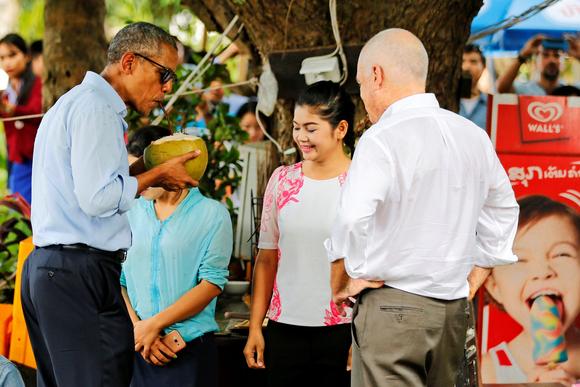BANGKOK — Laos’ new government is making a delicate diplomatic pivot away from huge neighbor China, its chief source of investment, and toward faraway superpower America despite their troubled history.
In an encouraging move, Barack Obama last month became the first sitting U.S. president to visit the landlocked Southeast Asian nation. Ordinary Laotians watched rapt media coverage of Obama sipping out of a coconut in the ancient city of Luang Prabang, where he spent nearly a full day before attending a regional summit in the capital Vientiane.
“I became an instant fan” of the president, a 33-year-old government worker said, describing him as “easy to like.”
The day before his outing, Obama met for two and a half hours with President Bounnhang Vorachith. Acknowledging that both countries share a tortured past they must work to overcome, Obama pledged $90 million in U.S. aid for clearing the estimated 3 million tons of unexploded bombs still remaining from the American bombing of Laos during the Vietnam War.
There has been a clear change in momentum for U.S.-Laos cooperation this year. The prime example of this is February’s conclusion of a bilateral investment pact, which covers trade, intellectual property, skills development and other areas of cooperation.
U.S. companies are keen on expanding into one of Southeast Asia’s least developed markets. In September, General Electric signed a memorandum of understanding on energy-related training and research with Electricite du Laos, the state power company. Fast-food chain Texas Chicken plans to open its first location in Laos by the end of this year.
The Obama administration has tried to rebalance U.S. diplomatic policy with a shift in emphasis from the Middle East to Asia. The president saw his visit to Laos as one of his greatest foreign policy achievements, a golden opportunity to clear away the poisoned legacy of the Vietnam War.
Course change
China has been Laos’ main source of foreign direct investment, providing a total of $5.3 billion since 2001 — 60% more than Vietnam, the second-largest source. The construction of a $6 billion long-distance railroad and the launch of Laos’ first satellite both owe to Chinese support.
These aid flows rose dramatically in the past five years. With Myanmar and Vietnam distancing themselves from China and deepening ties with the U.S., Laos grew in geopolitical importance for China as the only outlet for its southern expansion policy, said Adisorn Semyaem, a professor at Thailand’s Chulalongkorn University.
A turning point in Laos’ relationship with China came in April with a new government in Vientiane, led by Prime Minister Thongloun Sisoulith. Mr. Adisorn pointed PM has been changing in course toward a balanced approach to Beijing and Washington. Looming in the background of this shift is Vietnam. Most of the central figures in Laos’ government studied in Vietnam, which supported the founding of modern Laos in 1975 and continues to exert a strong political influence on the country. Thongloun’s new government came under pressure to correct the previous one’s overreliance on China, Adisorn Semyaem said.
Laos also harbors its own distrust toward China, especially toward its investments. Resentment can be heard in a village in central Laos where a Chinese company had mined for gold until a few years ago. “All that’s left is pollution and the unemployed,” a villager said. A number of Chinese-backed infrastructure projects have been shelved for various reasons, including a lack of transparency in the bidding process.
But a country aiming for 7.5% annual economic growth can hardly afford to spurn China’s liberal support and cast its lot with the U.S. overnight. Laos has of late seen a welcome increase in investment from neighboring Thailand. But Thongloun’s government still faces the daunting challenge of threading its way between two powers competing for influence in Asia.
Source: Nikkei Asian Review



